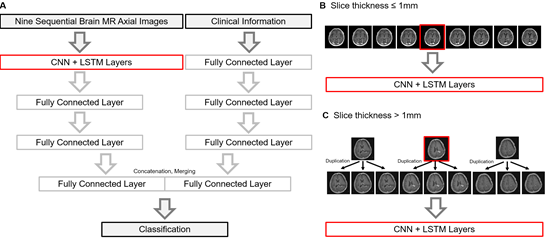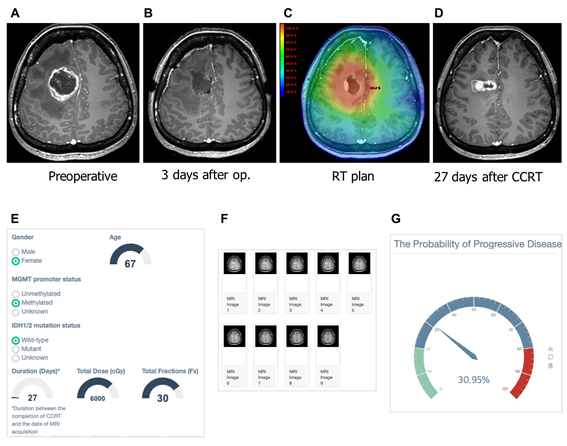글로벌 연구동향
방사선종양학
- 2020년 11월호
[Cancers (Basel).] Machine Learning Model to Predict Pseudoprogression Versus Progression in Glioblastoma Using MRI: A Multi-Institutional Study (KROG 18-07) 교모세포종 진행여부 예측위한 머신러닝 모델 : 다기관연구 (KROG 18-07)서울대 / 장범섭, 김인아*
- 출처
- Cancers (Basel).
- 등재일
- 2020 Sep 21
- 저널이슈번호
- 12(9):E2706. doi: 10.3390/cancers12092706.
- 내용
-
Abstract
Some patients with glioblastoma show a worsening presentation in imaging after concurrent chemoradiation, even when they receive gross total resection. Previously, we showed the feasibility of a machine learning model to predict pseudoprogression (PsPD) versus progressive disease (PD) in glioblastoma patients. The previous model was based on the dataset from two institutions (termed as the Seoul National University Hospital (SNUH) dataset, N = 78).Prediction of Pseudoprogression versus Progression using Machine Learning Algorithm in Glioblastoma (PMID: 30131513) To test this model in a larger dataset, we collected cases from multiple institutions that raised the problem of PsPD vs. PD diagnosis in clinics (Korean Radiation Oncology Group (KROG) dataset, N = 104). The dataset was composed of brain MR images and clinical information. We tested the previous model in the KROG dataset; however, that model showed limited performance. After hyperparameter optimization, we developed a deep learning model based on the whole dataset (N = 182). The 10-fold cross validation revealed that the micro-average area under the precision-recall curve (AUPRC) was 0.86. The calibration model was constructed to estimate the interpretable probability directly from the model output. After calibration, the final model offers clinical probability in a web-user interface.
그림1. A는 기본적인 모델 구조의 모식도이며 B는 입력하는 이미지의 방식을 설명한 것임.

그림 2. A-D: 뇌종양환자의 케이스, D와 같은 경우일 경우 실제 병변이 진행했을 확률이 어느정도인지 궁금할 때 E-F처럼 정보를 입력하면 G처럼 결과가 나오도록 유저인터페이스를 구축함.
Affiliations
Bum-Sup Jang 1 , Andrew J Park 2 , Seung Hyuck Jeon 3 , Il Han Kim 4 , Do Hoon Lim 5 , Shin-Hyung Park 6 , Ju Hye Lee 7 , Ji Hyun Chang 4 , Kwan Ho Cho 8 , Jin Hee Kim 9 , Leonard Sunwoo 10 , Seung Hong Choi 11 , In Ah Kim 1 12
1 Department of Radiation Oncology, Seoul National University Bundang Hospital, Seongnam 13620, Korea.
2 Artificial Intelligence Research and Development Laboratory, SELVAS AI Incorporation, Seoul 08594, Korea.
3 Graduate School of Medical Science and Engineering, Korea Advanced Institute of Science and Technology, Daejeon 34141, Korea.
4 Department of Radiation Oncology, Seoul National University Hospital, Seoul 03080, Korea.
5 Department of Radiation Oncology, Samsung Medical Center, Sungkyunkwan University School of Medicine, Seoul 06351, Korea.
6 Department of Radiation Oncology, School of Medicine, Kyungpook National University, Daegu 41944, Korea.
7 Department of Radiation Oncology, Pusan National University Hospital, Busan 49241, Korea.
8 The Proton Therapy Center, Research Institute and Hospital, National Cancer Center, Goyang 10408, Korea.
9 Department of Radiation Oncology, Dongsan Medical Center, Keimyung University School of Medicine, Daegu 42601, Korea.
10 Department of Radiology, Seoul National University Bundang Hospital, Seongnam 13620, Korea.
11 Department of Radiology, Seoul National University Hospital, Seoul 03080, Korea.
12 Department of Radiation Oncology, Cancer Research Institute and BK21 Four-Smart Healthcare, College of Medicine, Seoul National University, Seoul 03080, Korea.
- 키워드
- glioblastoma; machine learning; pseudoprogression; radiotherapy.
- 연구소개
- 뇌종양 환자의 추적관찰 MRI 이미지 상에서 질병의 진행여부를 판단할 수 있는 모델을 만들고자 이전에 단일기관에서 개발하였습니다. 이번에 이 모델을 국내 다기관의 데이터에 적용해보고 모델의 적정성을 평가한 다음 국내 사용자들이 이용하기 용이하도록 보정작업을 거쳐 유저플랫폼까지 제공한 연구입니다.
- 덧글달기
- 이전글 [Int J Radiat Oncol Biol Phys.] Combined NK Cell Therapy and Radiation Therapy Exhibit Long-Term Therapeutic and Antimetastatic Effects in a Human Triple Negative Breast Cancer Model
- 다음글 [Radiat Oncol.] Efficacy of orbital radiotherapy in moderate-to-severe active graves' orbitopathy including long-lasting disease: a retrospective analysis







